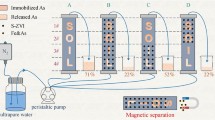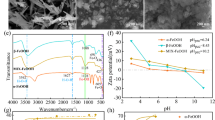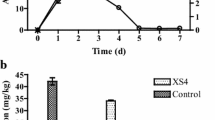Abstract
A low crystalline Fe-oxyhydroxy sulfate (FeOS) was used to immobilize arsenic (As) in soils in this study. The effects of FeOS amount, treatment time and soil moisture on As immobilization were investigated. The results showed that water-soluble and NaHCO3-extractable As were immobilized by 53.4–99.8 and 13.8–73.3 % respectively, with 1–10 % of FeOS addition. The highest immobilization of water-soluble (98.5 %) and NaHCO3-extractable arsenic (47.2 %) was achieved under condition of 4 % of FeOS and 80 % of soil moisture. Further, more amounts of FeOS addition resulted in less time requirement for As immobilization. Sequential chemical extraction experiment revealed that easily mobile arsenic phase was transferred to less mobile phase. The FeOS-bonded As may play a significant role in arsenic immobilization. Under leaching with simulated acid rain at 60 times pore volumes, accumulation amount of As release from untreated soil and soil amended with FeOS were 98.4 and 1.2 mg, respectively, which correspond to 7.69 and 0.09 % of total As amounts in soil. The result showed that the low crystalline FeOS can be used as a suitable additive for arsenic immobilization in soils.










Similar content being viewed by others
References
Antelo J, Fiol S, Gondar D, López R, Arce F (2012) Comparison of arsenate, chromate and molybdate binding on schwertmannite: surface adsorption vs anion-exchange. J Colloid Interface Sci 386:338–343
Ascher J, Ceccherini MT, Landi L, Mench M, Pietramellara G, Nannipieri P, Renella G (2009) Composition, biomass and activity of microflora, and leaf yields and foliar elemental concentrations of lettuce, after in situ stabilization of an arsenic-contaminated soil. Appl Soil Ecol 41:351–359
Blgham JM, Schwertmann U, Carlson L, Murad E (1990) A poorly crystallized oxyhydroxysulfate of iron formed by bacterial oxidation of Fe(II) in acid mine waters. Geochim Cosmochim Acta 54:2743–2758
Boily JF, Gassman PL, Peretyazhko T, Szanyi J, Zachara JM (2010) FTIR spectral components of schwertmannite. Environ Sci Technol 44:1185–1190
Burton ED, Bush RT, Johnston SG, Watling KM, Hocking RK, Sullivan LA, Parker GK (2009) Sorption of arsenic(V) and arsenic(III) to schwertmannite. Environ Sci Technol 43:9202–9207
Carbonell-Barrachina AA, Rocamora A, García-Gomis C, Martínez-Sánchez F, Burló F (2004) Arsenic and zinc biogeochemistry in pyrite mine waste from the Aznalcóllar environmental disaster. Geoderma 122:195–203
Chiang KY, Lin KC, Lin SC, Chang TK, Wang MK (2010) Arsenic and lead (beudantite) contamination of agricultural rice soils in the Guandu Plain of northern Taiwan. J Hazard Mater 181:1066–1071
García-Sanchez A, Alvarez-Ayuso E, Rodriguez-Martin F (2002) Sorption of As(V) by some oxyhydroxides and clay minerals. Application to its immobilization in two polluted mining soils. Clay Miner 37:187–194
Guo X, Du Y, Chen F, Park HS, Xie Y (2007) Mechanism of removal of arsenic by bead cellulose loaded with iron oxyhydroxide (β-FeOOH): EXAFS study. J Colloid Interface Sci 314:427–433
Hartley W, Edwards R, Lepp NW (2004) Arsenic and heavy metal mobility in iron oxide-amended contaminated soils as evaluated by short- and long-term leaching tests. Environ Pollut 131:495–504
Jomova K et al (2011) Arsenic: toxicity, oxidative stress and human disease. J Appl Toxicol 31:95–107
Jönsson J, Persson P, Sjöberg S, Lövgren L (2005) Schwertmannite precipitated from acid mine drainage: phase transformation, sulphate release and surface properties. Appl Geochem 20:179–191
Kim JY, Davis AP, Kim KW (2003) Stabilization of available arsenic in highly contaminated mine tailings using iron. Environ Sci Technol 37:189–195
Kim KR, Lee BT, Kim KW (2012) Arsenic stabilization in mine tailings using nano-sized magnetite and zero valent iron with the enhancement of mobility by surface coating. J Geochem Explor 113:124–129
Ko MS, Kim JY, Bang S, Lee JS, Ko JI, Kim KW (2012) Stabilization of the As-contaminated soil from the metal mining areas in Korea. Environ Geochem Health 34:143–149
Komárek M, Vaněk A, Ettler V (2013) Chemical stabilization of metals and arsenic in contaminated soils using oxides—a review. Environ Pollut 172:9–22
Kumpiene J, Lagerkvist A, Maurice C (2008) Stabilization of As, Cr, Cu, Pb and Zn in soil using amendments—a review. Waste Manag 28:215–225
Kumpiene J, Fitts JP, Mench M (2012) Arsenic fractionation in mine spoils 10 years after aided phytostabilization. Environ Pollut 166:82–88
Lee JE, Kim Y (2008) A quantitative estimation of the factors affecting pH changes using simple geochemical data from acid mine drainage. Environ Geol 55:65–75
Liao Y, Liang J, Zhou L (2011) Adsorptive removal of As(III) by biogenic schwertmannite from simulated As-contaminated groundwater. Chemosphere 83:295–301
Mench M, Vangronsveld J, Clijsters H, Lepp NW, Edwards R (1999) In situ metal immobilization and phytostabilization of contaminated soils. In: Phytoremediation of contaminated soil and water. CRC Press, Boca Raton, p 323
Moore TJ, Rightmire CM, Vempati RK (2000) Ferrous iron treatment of soils contaminated with arsenic-containing wood-preserving solution. Soil Sediment Contam 9:375–405
Ng JC, Wang J, Shraim A (2003) A global health problem caused by arsenic from natural sources. Chemosphere 52:1353–1359
Nielsen SS, Petersen LR, Kjeldsen P, Jakobsen R (2011) Amendment of arsenic and chromium polluted soil from wood preservation by iron residues from water treatment. Chemosphere 84:383–389
Paikaray S, Göttlicher J, Peiffer S (2011) Removal of As(III) from acidic waters using schwertmannite: surface speciation and effect of synthesis pathway. Chem Geol 283:134–142
Regenspurg S, Brand A, Peiffer S (2004) Formation and stability of schwertmannite in acidic mining lakes. Geochim Cosmochim Acta 68:1185–1197
Subacz JL, Barnett MO, Jardine PM, Stewart MA (2007) Decreasing arsenic bioaccessibility/bioavailability in soils with iron amendments. J Environ Sci Health A 42:1317–1329
Wenzel WW, Kirchbaumer N, Prohaska T, Stingeder G, Lombi E, Adriano DC (2001) Arsenic fractionation in soils using an improved sequential extraction procedure. Anal Chim Acta 436:309–323
Xenidis A, Stouraiti C, Papassiopi N (2010) Stabilization of Pb and As in soils by applying combined treatment with phosphates and ferrous iron. J Hazard Mater 177:929–937
Zhu YG, Williams PN, Meharg AA (2008) Exposure to inorganic arsenic from rice: a global health issue? Environ Pollut 154:169–171
Acknowledgments
The authors gratefully acknowledge National Natural Science Foundation of China (51304251) and the Key Project of Science and Technology of Hunan Province, China (2012FJ1010), for financial support.
Author information
Authors and Affiliations
Corresponding author
Additional information
Responsible editor: Zhihong Xu
Rights and permissions
About this article
Cite this article
Yang, Z., Liu, L., Chai, L. et al. Arsenic immobilization in the contaminated soil using poorly crystalline Fe-oxyhydroxy sulfate. Environ Sci Pollut Res 22, 12624–12632 (2015). https://doi.org/10.1007/s11356-015-4455-1
Received:
Accepted:
Published:
Issue Date:
DOI: https://doi.org/10.1007/s11356-015-4455-1




